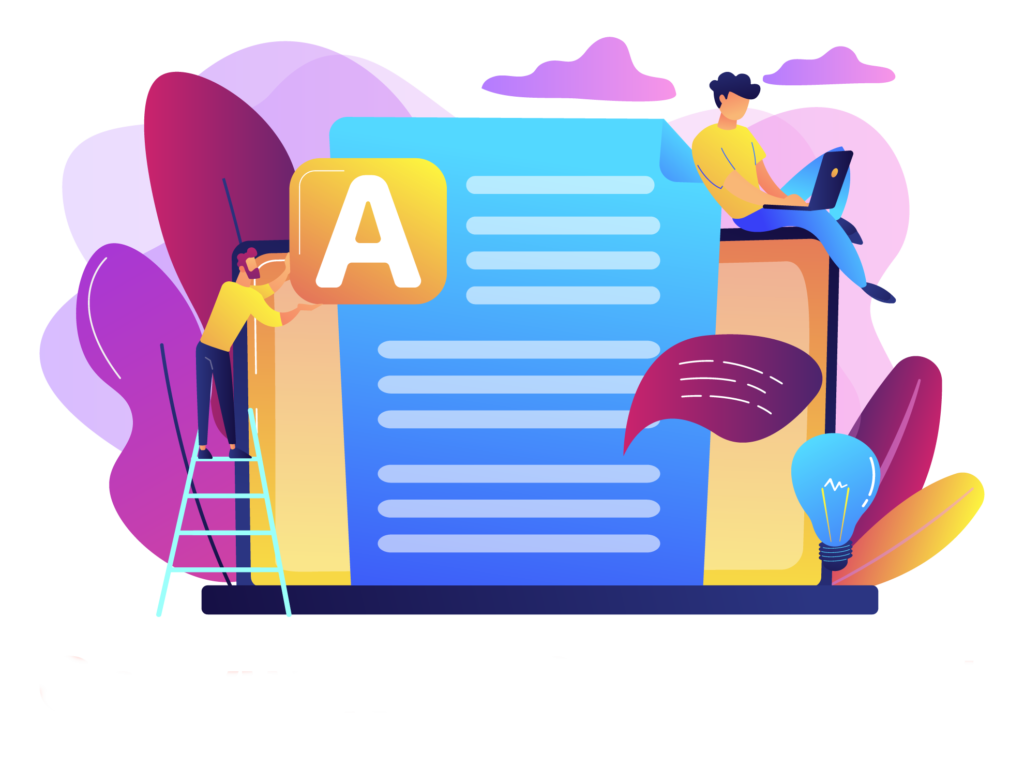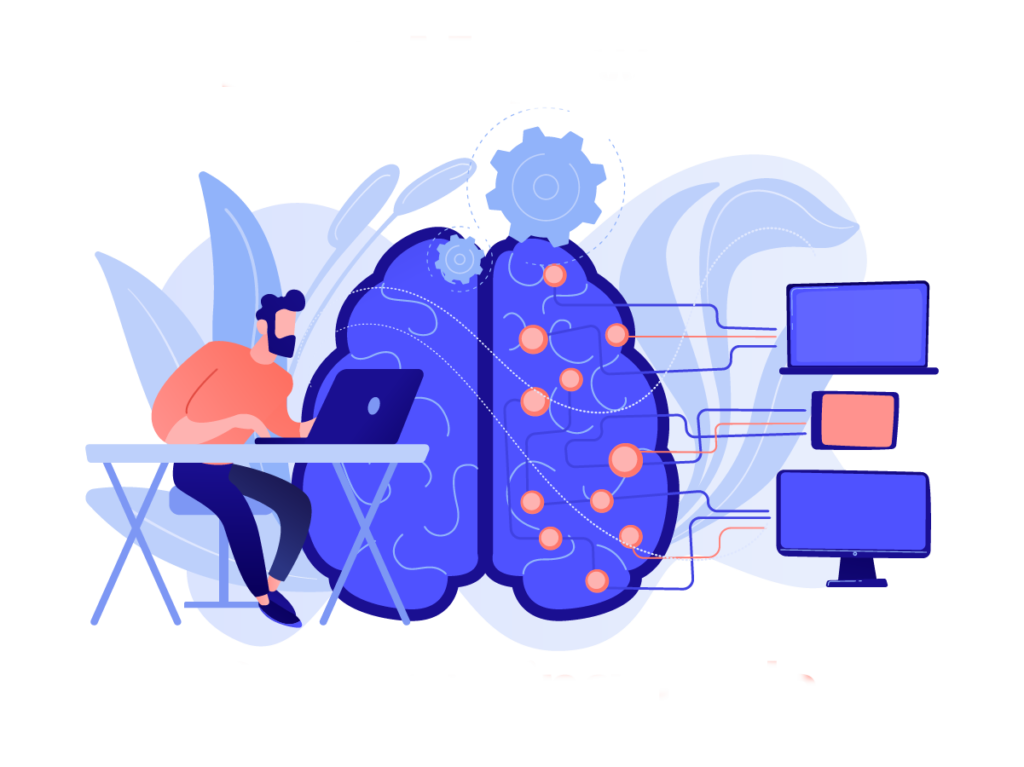Are you looking to grow your business and have the knowledge and expertise to create copy content, and do you want to build a Copywriting Department? In this article, we’ll tell you all about how to create a new department to offer your copy expertise, from the services you should be prepared to provide and how to showcase them to how to create a workflow that allows you to deal with a high amount of projects.
The idea for this article emerged because 2021 was a growing time here at Scalater; we received awards and celebrated our first anniversary of life. We’ve continued growing and working hard, and we’re now proud to announce the launching of our brand new Copywriting Department. Most of this document will take inspiration from our own journey to create the copy department and how we recommend doing things. We’ll give some examples of our content based on our expertise and business interests, and we’ll also provide examples of content that fits any business in any industry.
Here are the headlines of our Copywriting Department to give you an idea.
In our Copyrighting Department, we can write in-depth articles about several topics related to business, web optimization, marketing, and software development.
- We offer articles from 800 to 2000 words long in 3 to 5 workdays.
- Our services include the article’s writing and production of images/illustrations from several means (creating or buying from stock) and formating. (We do not post nor receive credentials for article posting from any customer)
- We use Imbound marketing techniques and a native marketing approach to generate non-invasive pieces that attract your audience instead of disrupting their navigation experience.
- In Scalater, we take our Copywriting Department very seriously and take care of its integrity out of respect for your/our customers and readers. We only write for actual pages managed by real people targeting real people.
In those short lines, we depicted almost all aspects of the department: what we offer, our professional approach to the work, technique, and methodology, and our emotional and professional opinion about our job. This generates a sensation of certainty and mindfulness work in the readers. They feel they know you. You’ll need to walk the steps and put the grind into it to get to this. And we’ll help you in every step.
Why create a Copywriting Department
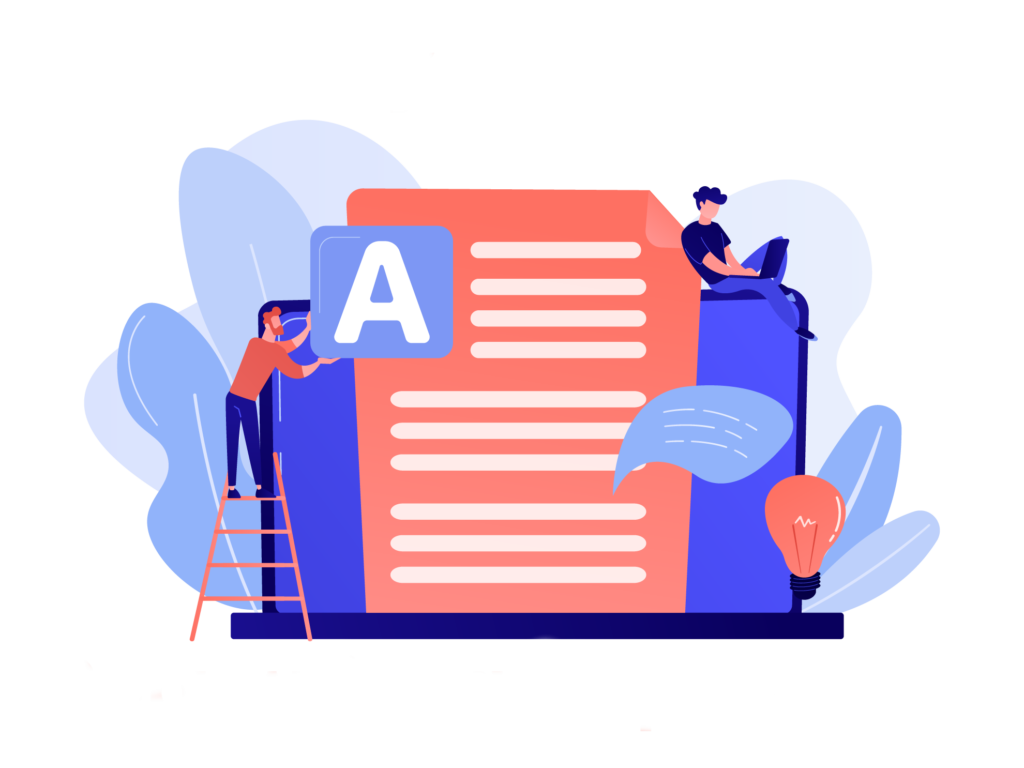
If you’re reading this but you haven’t decided to start a new department, you might be wondering why to create it in the first place. And it’s a pretty understandable position to be in.
Ask yourself this: How much business will we lose without a copy department? Copywriting can increase your agency’s profits and grow your reputation as an industry leader. Without the ability to create compelling content and messaging for your clients, you’ll lose opportunities to retain current clients, land new ones, and make more money.
One of the most valuable contributions that copywriting can make to your agency is increasing its profitability. How? By creating higher-quality proposals and winning more business. If you can win just one extra deal a year, your new department will be paying for itself. Also, having a copywriting department in your agency is the best way to ensure that all of your clients receive top-notch content.
The truth is that qualified copywriters are worth their weight in gold. In fact, they’ll make so much money for your agency that you’ll actually lose business if you don’t have one on staff.
Content
This article contains the following steps to create a Copywriting Department in your own agency:
- Management
- Methodology and Guidelines
- Workflow
- Marketing
- Scalater’s Way.
Management

Managing a copywriting department can be difficult and time-consuming if you don’t know what you’re doing. From how much you need to produce to maintaining the department and making a profit to creating a streamlining work to automate most of it and generate better earning margins. We’ll talk about all of it.
Target
Start by identifying what types of businesses you want to market to. Then target those businesses to find their needs. For example, do they need print ads, or are they looking for video marketing like YouTube videos? Once you know what type of writing you want to do, find out how much money is available for this effort. The size of the project will determine how many people you will need, so it is vital to decide on your budget before hiring staff.
Ensure you’re targeting business inside your team’s area of experience and try not to write for industries you don’t know that well. This tip is for the department’s first steps; in the future, you can have a bigger team with writers in other business areas to expand your content offer. Don’t try to sign every customer just to have their business because it can negatively affect your reputation and image. Make sure you grow organically.
Budget
One of the essential factors in creating a copywriting team in your agency is whether you can make the budget work. And it’s a balancing act: you need to know how much money you would need to hire great writers, but you also want to be able to see how having those writers on board will help your agency become more profitable.
Creating a budget for your copywriting department is to think about how your agency already works with copywriters and what the process might look like if you had a copywriter in-house. You’ll need to take an honest look at your business and understand what writing services your clients are already paying for you to provide—and what they’re not.
The first step is to determine how much of a role copywriting plays in your overall services. What percentage of projects involve some kind of written content? How much time are your account managers spending on writing and editing? What types of fees do you charge for those projects? If you were to hire a copywriter, what would their salary be? Now that you know this information, it’s time to take a closer look at your existing clients.
Take a look at the current active accounts that have been in the agency for at least one year. This will give you an accurate idea of how much business your clients need from the agency annually. How many projects have they completed over the past year? How much time did they spend with account managers working on their content? And, How much did they pay for those services? Estimating how many projects they’re likely to have next year based on historical data.
Now, just add the costs and the earnings, and you’ll know how much money you have to generate to reach profitability, which is the first step; getting to the green.
Tip 1
Start by adding up the costs of hiring for all of your available positions, any software that you’ll need to run things smoothly, and then add a little extra just in case. Don’t worry about being too precise; at this point, you’re just getting an estimate together. Look at your current monthly expenses once you have that number in hand. Requesting additional funds shouldn’t be a problem if you show that you have room for the new department in your current budget!.
Tip 2
The next time you’re writing an agency proposal, take this approach:
- Start by reviewing the client’s request for proposal (RFP) or brief.
- Look at all the questions and copy suggestions. Estimate how many hours it would take you to answer each question and write the suggested copy, assuming that you had no other work on your plate.
- Use these hours as a baseline for how much time you’ll need to do a thorough job on the proposal or brief—and use this number as your starting point when estimating project costs.
Projects Management
Ensure you’ve got an efficient way of tracking all tasks assigned throughout each day so nothing slips through the cracks! Suppose someone doesn’t complete something within their allotted time frame. In that case, it’s up to management (you) to follow up with them until completion has been achieved-this is especially important when working in teams where multiple people may be responsible.
To manage a large number of projects at the same time is better to have a project management software like Atlassian, the one we use on Scalater. More about that in the Workflow subject.
Hiring
Anyone who writes marketing materials is a copywriter, and your agency will probably write mostly ads and sales letters. But any piece of writing or video that can be considered advertising needs the expertise of a professional copywriter.
Don’t just hire anyone who says they can write because there’s no way for you to know if they’ll actually do a good job or not. The best thing you can do is find qualified writers with experience in your industry so that they understand what it takes to produce quality content for your clients’ needs.
A good copywriter can write well and keep up with what’s trending in their industry. They also must be able to work with the team to meet deadlines and stay within budget.
The best way to find quality candidates is by posting your job opening on websites like LinkedIn or Indeed. If you don’t have any luck there, try contacting local colleges and universities for recent graduates who might fit the bill.
Once you’ve hired someone, they must understand what your company does so they can write about it in an engaging way that will connect with readers.
You might also consider bringing in an outside contractor for small projects until you can afford to hire an in-house copywriter. Either way, you should be able to show leadership that although your writer may cost money upfront, they will pay for themselves with their excellent work and your guidance.
Here are some tips for your copy team:
- Have your writers work on different projects at the same time.
- Keep your writers up-to-date with the latest news in their field
- Be clear about what’s expected of them
- Make sure they know they have a say in what they write
- Track their progress and give them feedback when it’s needed
- Teach them how to use your project management software and make sure they use it.
Methodology and Guidelines

This section is about the way you operate toward your customer and how you expect them to act towards you. Here’s all about transparency and expectation management. You have to let the prospects know how you will do your work and how many steps are required. In all, what to expect from you. At the same time, you can communicate what you are expecting from your customer’s behavior. It’s also critical that you establish clear and concise communication lines with the correct “codes” so everyone understands everyone.
To help you understand this, we’ve prepared examples of what these texts should look like.
Work Methodology
Here you can communicate a layout of your work process; what are you going to do and how. You are always putting your values as a way to bring security and professionalism.
Example:
We’ve always liked transparency and disclosure when working. As for that, here are our guidelines and directrices that guide us in our work, always assuming complete professionalism and seriousness.
Our work will always abide by the following conditions:
- Write an article of at least 800 words. (Stablish a minimum of words you’re willing to write to keep profitability)
- Write original content, never duplicated nor posted on any other Site of the www. (Ensure the quality and originality of your content)
- Write an article created by the one indicated as the “author” and never use content from another author or ghost authors. (Always communicate who is writing the piece requested)
- We write about Web development, plugin development, anything WordPress-related Digital Marketing, and related content. (Clearly establish the subjects you’re writing about based on your team’s expertise and passions.
- We won’t write any content with racial, sexual, nationality, or any other kind of discrimination, personal insults, or attacks, and nothing containing pornography of any kind. (Take a stand and communicate some of your core values)
- We work with two revisions,
- The first revision is at 50% of the article writing
- The second revision is at 100% of the article writing
- The time the customer takes to conclude every revision isn’t included in the total estimated time for the project.
- The customer has 48 hours to return the corrections, or the job will be deemed concluded, the money not returned, and any work done will automatically be the property of Scalater to do with it as we consider fit, including publishing on our own.)
- The customer can extend one of the revisions periods up to 72 hours
Clearly communicate the project’s time management and how you will integrate the customer’s feedback into the work. Establish firm but reasonable delivery terms, always leaving some room for flexibility. Finally, have some deal break clause if a project loses profitability by customer responsibility.
Brief Guidelines
In the brief guidelines, you can express how you expect the customer presents a project request to you. Ask for any materials, content, admin credentials, or branding material you might need to finalize your customer’s project.
Example:
To begin a project, we need the following material beforehand:
- Article subject: Try to be the most detailed as possible.
- Article tone: Professional, friendly, funny, etc.
- Suggested title: The more, the better.
- Keywords: Main and secondary keyword phrases.
- Meta-descriptions: suggestions or definitive ones.
- Approx amount of words: The articles have 100 words margin.
- All the desired anchors and links: If you want some links added to your article, you have to provide us with the links and the suggested or definitive anchor text for each of them.
- Publisher’s website.
- Intended Target
In addition, if you’re offering the services of posting the copy on social networks, you should ask for credentials for each of the platforms you’ll be posting on.
Delivery Guidelines
In pursuit of transparency, clearly determine what your final product will look like, which are the accomplishment parameters, and what can be expected.
Example:
Every article delivered to our customers will have these elements.
- The article’s copy content (at least 800 words)
- A Featured Image. Plus, any other picture that the customer chooses in both revisions. (Original content only)
Prices Guidelines
Create an easy-to-understand and straightforward payment scheme. Establish a minimum price (based on profitability) and make the prices scalable so it’s easy to estimate the costs. Also, explain how the work is charged and why.
Example:
- Because the minimum amount of words we deliver in every article is 800 with 1 (featured) image, the minimum price is 105USD per article.
- We charge 10USD per 100 words.
- We also charge between 5 and 10USD per illustration or photography. Images will alter the final price of the piece.
- Depending on the nature of the image, the price can vary significantly. (illustrations are more valuable than stock photos, for example.
Payments Guidelines
This part is pretty straightforward but vital. Express how and when the customer should pay you. If you need money to begin the project, you should ask for an initial payment and then charges associated with the project’s advances.
Example:
- 50% of the money will be paid to Scalater before the work starts
- 50% of the funds will be delivered to Scalater after the second revision is concluded.
- The payment details and account number will be discussed once we have an agreement on the project.
The Methodology and Guidelines section taught us that expectations are fundamental when closing a business and receiving the final product/service. To avoid problems in this matter with your customers, always communicate with the most transparency your work methodology, time and schedules, cost and payment system, and any other subject that you deem essential to the final goal; to close the business and deliver like a champ.
Copywriting Department Workflow

Now, workflow is all about order and structure. Using the deductive method, create a visual representation of the work in a time scale like a Gantt Chart. Now, a Gantt Chart is an outdated tool to work with, so we’ll need an online, interactive, and real-time way to depict that image for the team and us: Enters Atlassian Suite. At Scalater, we use Jira and Confluence, both Atlassian software, to manage several simultaneous workflows.
Jira
Allows you to establish long, middle, and short-term goals associated with the tasks needed to accomplish them, and everything is aligned with a timescale. This project manager lets everyone know the work other team members are doing, when, what’s their work about, its due time, and the level of completion. This way, you generate a horizontal, easy-to-understand, and shared workflow, allowing you to track, give feedback in real-time, and have an overall understanding of the progress at a glance or in deep if you want to.
Confluence
Here is where you actually create the writing content. You have hundreds of free templates to make all kinds of documents and create your own; newsletters, blog posts, social media posts, all sorts of ads, and even project proposals. Here you have spaces for each of your projects, so you don’t mix departments and tasks. In those spaces, your writers can generate their content, accessible to everyone in real-time, where you can leave notes or even modify the work itself.
All the documents you create in Confluence can be linked to their respective task in Jira, so you have both the workflow and the content creation areas in one extensive ecosystem where your team can work very efficiently.
All the clearances for reading, editing, creating, and deleting are customizable, so you have different roles like administrator, editor, or creator. This way, you can limit what your team members can see or do. It is convenient for big teams or if you work with freelancers and don’t want them to know about the rest of your work or a new person to whom you can gradually give access.
Tip
Don’t forget to assign someone to be the chief copywriter or editor, so that person defines the editorial lines and makes sure the deadlines are met.
So, you have a public, dynamic, and treatable public space to create the content and manage the workflow, tasks, goals, and deadlines, assembling a team-spirited way of working by transparency and horizontality. Everyone knows what everyone is doing—a Very Silicon Valley way of doing things if you ask me.
We created several templates for ourselves to fulfill various purposes. For example, our blog article template looks like this:
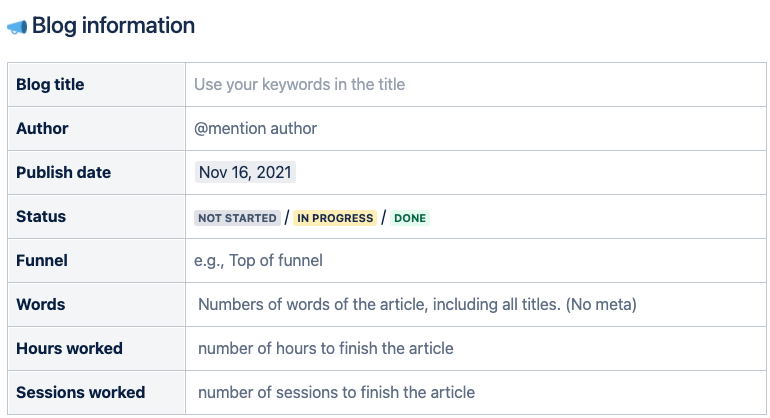
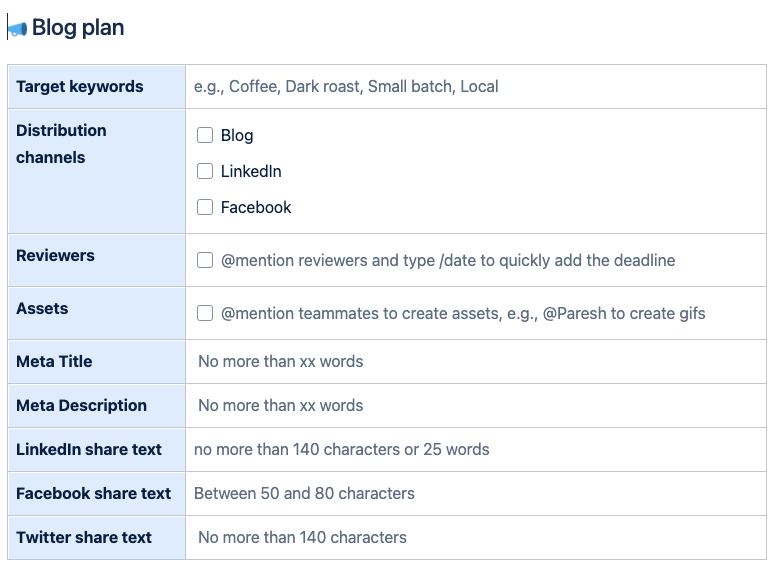

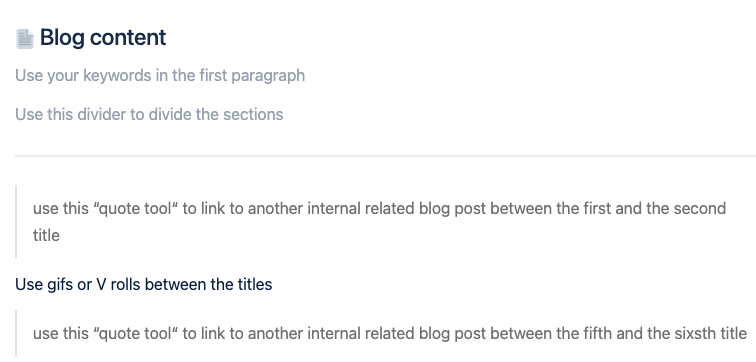
Our blog template shows that we have almost all the information the writer, the editor, the manager, and the publisher might need right there in the article’s header. You know at a glance who is writing, what’s writing about, the publishing day, which platforms you’re publishing the content on, and how much time it took to complete. Plus all kinds of SEO and format information if you have a community manager in charge of publishing the content, so they know how to SEO optimize the article.
You don’t have to use this software to manage your workflow, but we strongly recommend you to use some software to handle it because it can be very chaotic if you don’t, and there are excellent options, both free and paid.
Having a process in place will help keep everyone on the same page, streamline production times and ensure that deadlines are met without compromising quality control standards set forth by management or clients themselves.
Marketing

The best marketing strategy (and tactic) is to have a blog and a newsletter. Create the content you’re offering for your business and show them how you work. Have an opinion about relevant news, and talk about other companies and key individuals in your industry. Have at least a couple of every kind of content you offer on display and working for your company. Send newsletters with the newest of your company and share the most critical articles in your blog.
Make sure you publish regularly and on schedule. Your own success will be the perfect marketing campaign for your Copywriting Department and make everybody know that there is a new copy team in town.
Now, there are some tactics you can apply to sell your new services:
- Identify critical prospects you want to sell to.
- Identify their copy needs, propose a content plan, and even send a free content sample that is useful for them.
- Create a template pitch letter to engage different kinds of business.
- Proceed to send a lot of prospection emails. (Starting with the template, try to write a message as personalized as possible for each prospect)
- You can get a lot of quotations and meetings in a short amount of time doing this, so we recommend that you have a person in charge of this; yourself, a member of your team, or even someone from the marketing or sales department.
Below is a list of article models you can offer to almost any business.
Most Requested Articles
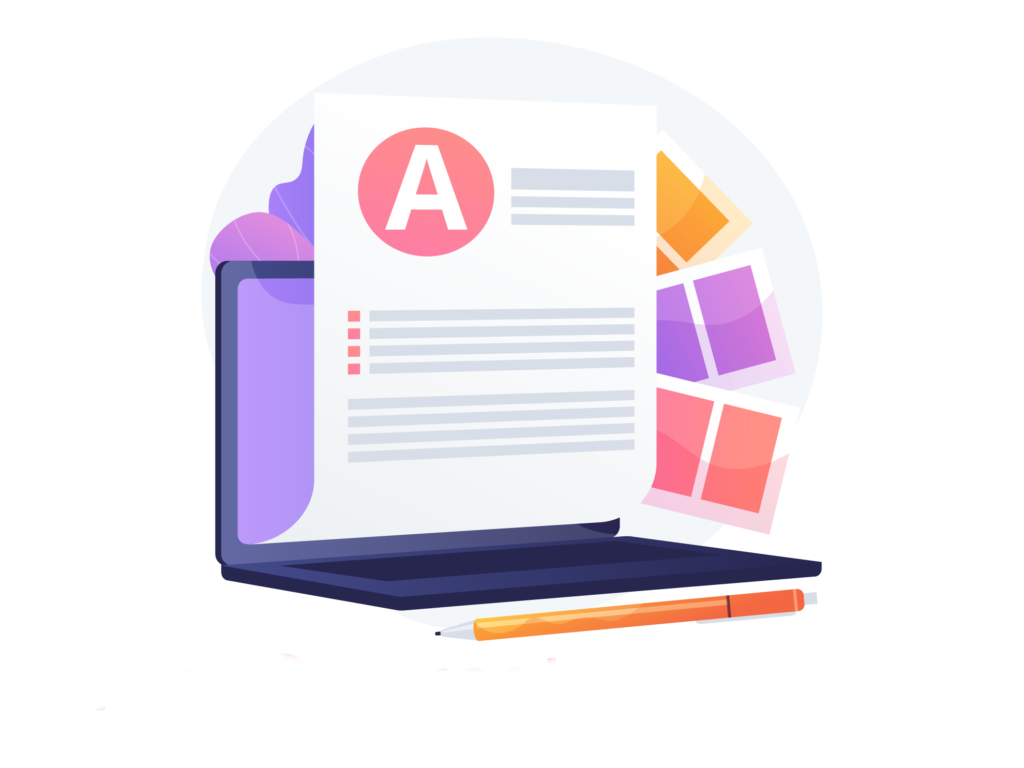
The following topics are the most requested for our clients and the market in general.
Article about your product/services using native marketing
This means the piece is not about your product. However, it’s natively embedded in the article, just not the main topic—an excellent way to talk about your business, avoiding communicating a too egocentric image. We all know that self-centered and disruptive ads are not to the liking of many.
- It has a temporary nature; you can’t repeat this content often.
- Suitable as a presentation card for your industry and audience
- Good as one of your first 5 or 10 articles
- Good for your newsletter
- Ideally, around 500 and 800 words.
An example of this is the Web Optimization series we have in our Magazine:
- Why is web optimization so important
- A Practical Guide to Managing SEO on Your Website or E-commerce
- A Step-By-Step Guide to Create a Successful Blog for your Web or E-commerce
- A Comprehensive Web Optimization & SEO Glossary for 2022
Tops and Lists
Write about the apps, systems, and methodologies your company uses or compile a list of the best in the market and recommend them to your audience.
- Very high demand
- Excellent content for social media
- Easy to write
- Can write many of them and don’t gets old as fast
- Ideally, around 800 and 1000 words.
Here are some examples from our Magazine:
- 9 Web Development Tendencies for 2022
- Top 10 Apps for Small Businesses in 2022
- Top 5 Content Management Systems For Online Businesses
How to’s and Tutorials
The goals are two: to teach and to generate authority by conveying your team’s accumulated experience and know-how into a piece that is didactic, easy to read and follow, and relatively short, depending on the subject.
- Hig demand on social media
- Generates authority
- Can write many of them
- Ideally, around 800 and 1000 words.
Some examples for our Magazine are:
- A Step-By-Step Guide to Create a Successful Blog for your Web or E-commerce
- A Practical Guide to Managing SEO on Your Website or E-commerce
Article about the industry
Inbound marketing all the way here, folks. Here we use the most effective attraction techniques from inbound marketing to generate a piece that your intended target will want to read—using a combination of target research and the most relevant long and short-tail keywords; we appeal to the algorithm as well as to your readers. Here you can talk about news, noteworthy persons, businesses, or products/services, have a personal opinion, and share your company’s perspective. You achieve authority with the algorithm and your community by telling a story, informing, and convincing.
- Excellent to complement your usual content
- Inform your audience about new technologies and methods you’re planning to adopt or inform them about news relevant to your business
- Appropriate for your newsletter and LinkedIn
- Ideally, around 800 and 1000 words
Here are some examples:
- Software as a Service industry (SaaS); history and why it’s important
- Is a blog a Good Idea in 2022?
- E-Commerce since the 2019 Covid pandemic, what has changed
Article about one of your customers
Using Native Marketing, we write about why your customer’s life/work/love is so much better thanks to several elements being your product/service, the primary precursor of change, but not the primary issue in the piece; that is your customer.
- Give recognition to your community
- Relay authority in a native and not intrusive way
- Ideally, around 300 and 500 words
- Suitable for almost any platform
Price, Award, or Anniversary Article.
Did you win a distinction, and it’s your moment of shine? Don’t be afraid of showing off your accomplishments, primarily if this accomplishment is awarded by someone else. If an entity recognizes you, it’s ok to talk about you––a little bit.
Usually, these pieces are shorter (300 words avg.), and we write about your team, your beginnings, and where you are now—always thanking your customer for everything they’ve done for you, your team, and your business.
In the following examples, you’ll see how we openly talk about ourselves and congratulate ourselves but always give credit to the team, the customers, and the industry community we’re located in.
- Communicate your achievements and authority
- Good opportunity to thank and give recognition to your team and audience
- Excellent for platforms like LinkedIn or even your newsletter
- Ideally, around 300 to 500 words
These are the shorter pieces we have in our Magazine, and with reason.
- Clutch Announced Scalater as Uruguay’s Best Web Developer for 2021
- Scalater’s Year In Review On Clutch For 2021
- Scalater Anniversary
New year, holidays, and critical industry days.
Do you need to write something for these holidays but don’t have anything to say? Suppose you think that a specific day like Valentine’s Day, Earth International Day, Labor Day, or any other day related to your industry is important to you, but you don’t want to write because so. Most of cases, it is an important day; it is just a matter of finding the right angle for a story. Where there are people and business, there are stories, don’t worry about it.
- Fit to complement your usual content and as a nice shout out to your audience
- Ideally, around 300 and 500 words
- Adequate for almost every platform
Here are examples of this:
Interviews
Do you have access to a celebrity, VIP, or a respected public person in your industry? You have to take advantage of that and make a piece about it. Of course, we always center on the interviewees, their career, business, or anything that makes them unique or relevant. You’ll be perceived more like an authority and a force to be recon by being close to them.
These articles are a little more complex in terms of logistics because the interview should be carried out by someone who knows the industry and someone the interviewed already knows, and we don’t always have that person. This is more of a cooperation effort between you and us so we can get the best of this vital opportunity.
- Attracts a lot of audience and authority
- Hig demand on social media
- Good opportunity to generate networking with other businesses and relevant persons
- Ideally, around 800 and 1000 words
Principles declaration
Sometimes you want to say something about a person, a recent event, or your industry, and you don’t know how to build the message so that it sounds clear and is understood. The goal is to give your opinion as a business about a relevant subject for you and the industry, letting your audience know how you think and feel. Of course, the piece’s tone is professional and is not a personal opinion on the matter. Communicate the kind of business you have and how you and your team thinks.
- Generates trustworthiness
- Essential for your first 5 or 10 articles
- Ideally, around 500 and 800 words
Here are our principles declaration articles:
- Software as a Service industry (SaaS); history and why it’s important
- Welcome to South American Globalization
- How a Small Web Developer Business Can Help Mars Colonization
Cornerstone Content
This content is the most important in your blog/magazine, and you should periodically have entries surrounding these subjects. The subject matter of these articles is the heart of your business but is not about your product/services or company directly. These pieces can fit into any of the categories above. Still, when writing them, we need to have special care when selecting keywords, subjects, and titles, so you communicate the essentials in every entry and at the same time without repeating the topics published.
- Should publish every 1 or 2 month
- Suitable for the newsletter and specialized platforms
- Ideally, around 800 and 1000 words
Here are our keystone articles. -There is no coincidence in the fact that some of these pieces are the first ones we published-
- Software as a Service industry (SaaS); history and why it’s important
- Why use Shopify for your restaurant and drinks business?
- Is Selling Online Software As A Small Company Possible?
- Why is web optimization so important, A Practical Guide to Managing SEO on Your Website or E-commerce
- A Step-By-Step Guide to Create a Successful Blog for your Web or E-commerce
- A Comprehensive Web Optimization & SEO Glossary for 2022
You may have noticed that some of the articles repeated themselves in some categories, and that’s because a piece can serve many goals, especially your first few entries. A plan is essential when constructing your blog’s reputation and content. If you follow the plan, you can figure out how to use several pieces for several objectives without your audience even noticing it.
Images
Images are vital to your articles because they are the first thing your audience sees and accompanies the entry title. That is the featured image. We recommend pairing every h2 title with a picture so your readers don’t get tired of a plain text sheet. This is not for all cases; for example, you can add more images to the h3 or even the h4 titles if you have a very long article. In addition to that, you should try to add some spreadsheets, graphs, and numbers to add more credibility to and variety to your pieces.
Of course, you have to use images that relate to both the article’s content and the customer’s branding to generate an overall corporate image that makes sense to the visitors.
Example:
As a complement to your articles, we’re prepared to generate/buy photos, vectors, and montages suitable for the tone and subject of the article, complementing it natively and following your branding guidelines.
We have a team of illustrators and subscriptions to massive stock image providers, so we can always find the right pictures for your piece. If we need a picture of an interviewee, we can always arrange a photo session in their country, or you can provide us with the material if you already have it.
When offering your services, always give examples of how you’ve been doing that work so prospects know you better. Always remember to “show, don’t tell”.
How to Copywriting Department; the Scalater’s Way
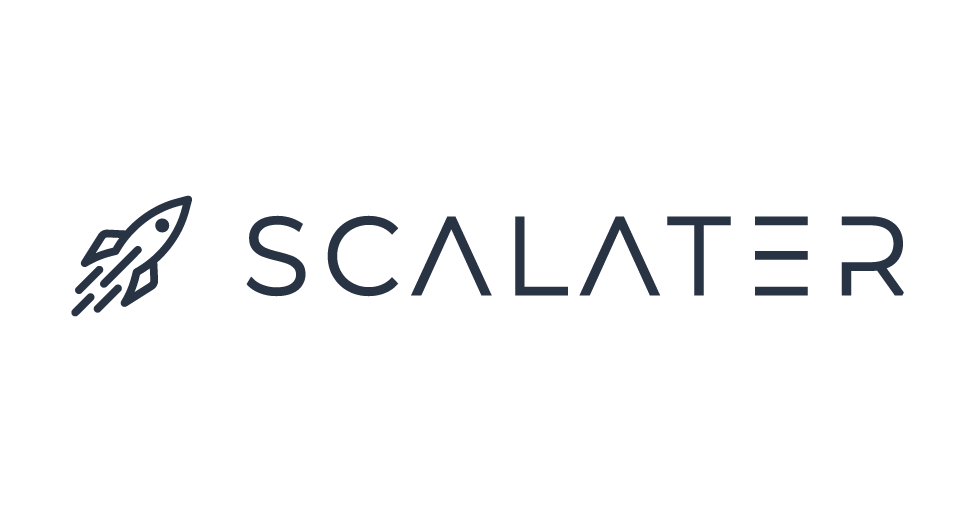
Most of the examples we saw are actual material from our Copywriting Department that we’re using right now. That’s what we meant by transparency; just show your work and how you do it. Revealing the inner pieces of your business are also a perfect way to go about your communication because it shows you have nothing to hide and that you’re sharing your accumulated knowledge for free. If you want to use these examples in your business, please feel free to do so; that’s the spirit.
When structuring any department, try to be the most simplistic possible and not add a process, a system, or a position where you don’t strictly need one. Ask yourself this question frequently; how can I automatize this process, delegate it or erase it altogether? Is this really necessary for the project to achieve the expectation you set for your work? A lot of the software we mention, that by the way we use, has features to deal with complex processes and make them simpler and even automatized. We recommend you check out those software’s free trial and see for yourself how well they will fit with your team and leadership style.
So, wrapping up. Thanks for dedicating your time to reading us. It is significant for us that the knowledge we put out there is helpful to someone; otherwise, it wouldn’t be worthwhile the passion, effort, and resources we put into it. So thank you for that, really.
All the fees in this article are referential only and do not represent the actual values we’ve set in the Scalater Copywriting Department.
Also, as we’re starting, you can ask us any questions you have or maybe request a quotation here: business@scalater.com. We’ll be happy to hear from you and to help you achieve a little piece of your dream.
As always, stay safe and stay sage.
Au revoir!!
